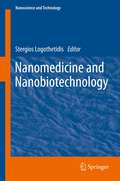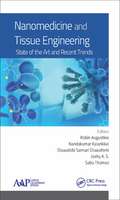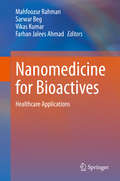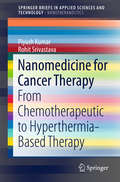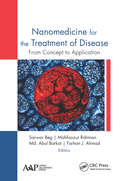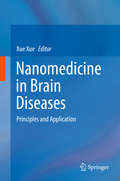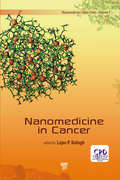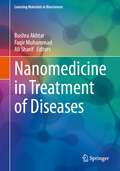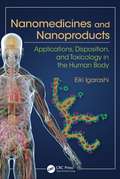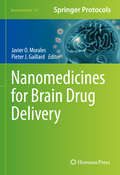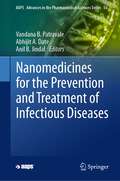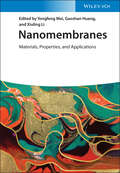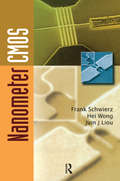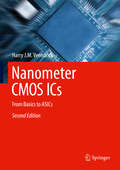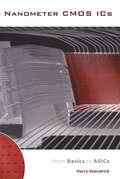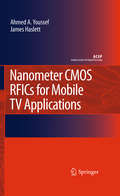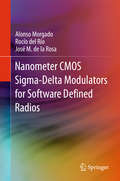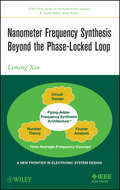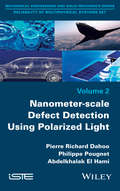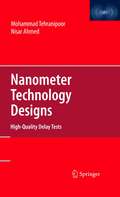- Table View
- List View
Nanomedicine and Nanobiotechnology (NanoScience and Technology)
by Stergios LogothetidisThis book presents the laboratory, scientific and clinical aspects of nanomaterials used for medical applications in the fields of regenerative medicine, dentistry and pharmacy. It gives a broad overview on the in vitro compatibility assessment of nanostructured materials implemented in the medical field by the combination of classical biological protocols and advanced non-destructive nano-precision techniques with special emphasis on the topographical, surface energy, optical and electrical properties. Materials in the physical form of nanoparticles, nanotubes, and thin films are addressed in terms of their toxicity. The different pillars of the Nanomedicine field are also highlighted. The book takes an interdisciplinary approach of medicine, biology, pharmacy, physics, chemistry, engineering, nanotechnology and materials science. The international group of authors specifically chosen for their distinguished expertise belong to the academic and industrial world in order to provide a broader perspective. It appeals to researchers and graduate students.
Nanomedicine and Tissue Engineering: State of the Art and Recent Trends
by Robin Augustine Nandakumar Kalarikkal Oluwatobi Samuel Oluwafemi Joshy K. S. Sabu ThomasThis book focuses on the recent advances in nanomedicine and tissue engineering. It outlines the basic tools and novel approaches that are becoming available in nanomedicine and tissue engineering and considers the full range of nanomedical applications which employ molecular nanotechnology inside the human body, from the perspective of a future pr
Nanomedicine for Bioactives: Healthcare applications
by Mahfoozur Rahman Sarwar Beg Vikas Kumar Farhan Jalees AhmadNanotechnology is opening up new avenues in all scientific and technological fields. Among the novel applications, bioactives and nutraceuticals are fast-growing areas of nano research for better healthcare solutions. A variety of nanoformulations, such as polymeric nanoparticles, nanocapsules, nanoemulsions, transferosomes and ethosomes, liposomes, lipospheres, and lipid polymer hybrid nanoparticles have proved valuable in bioactive delivery and food materials. Further, new herbal drugs and nutraceuticals are reported to have remarkable advantages over conventional formulations of plant actives and extracts, including enhanced solubility, bioavailability, multiple drug delivery, greater stability, sustained delivery, improved tissue macrophage distribution, protection from toxicity, enhancement of pharmacological activity and protection from physical and chemical degradation. This book focuses on the advanced nanomaterials that are utilized for the encapsulation of nutrients/vitamin/phytoconstituents, as well as their other healthcare benefits.
Nanomedicine for Cancer Therapy: From Chemotherapeutic to Hyperthermia-Based Therapy (SpringerBriefs in Applied Sciences and Technology)
by Piyush Kumar Rohit SrivastavaThis Brief focuses on the cancer therapy available till date, from conventional drug delivery to nanomedicine in clinical trial. In addition, it reports on future generation based nanotherapeutics and cancer theranostic agent for effective therapeutic diagnosis and treatment. Breast cancer was chosen as the model system in this review. The authors give emphasis to multiple drug resistance (MDR) and its mechanism and how to overcome it using the nanoparticle approach.
Nanomedicine for the Treatment of Disease: From Concept to Application
by Sarwar Beg Mahfoozur Rahman Abul Barkat Farhan Jalees AhmadThis new volume, Nanomedicine for the Treatment of Disease: From Concept to Application, looks at the application of nanomedicines with a particular focus on their use in the treatment of diseases. The chapters in this volume, contributed by eminent scientists, researchers, and nanotechnologists from across the globe, highlight key advancements, challenges, and opportunities in the area of application of nanomedicines for disease treatment. They explore the design and development of therapeutic nanocarriers for targeting drugs for satiating the demands of disease treatment process. The volume explores the use nanomedicines for the diagnosis and treatment of a multitude various diseases and health conditions, including respiratory diseases, neurological disorders, genetic diseases, pulmonary fungal infections, neuroAIDS, cardiovascular disorders, gastric and colonic diseases, skin disorders, cancer, brain tumors, leishmaniasis and other visceral diseases, hypertension, and ocular diseases.
Nanomedicine for the Treatment of Disease: From Concept to Application
by Sarwar Beg Mahfoozur Rahman Abul Barkat Farhan Jalees AhmadThis new volume, Nanomedicine for the Treatment of Disease: From Concept to Application, looks at the application of nanomedicines with a particular focus on their use in the treatment of diseases. The chapters in this volume, contributed by eminent scientists, researchers, and nanotechnologists from across the globe, highlight key advancements, challenges, and opportunities in the area of application of nanomedicines for disease treatment. They explore the design and development of therapeutic nanocarriers for targeting drugs for satiating the demands of disease treatment process. The volume explores the use nanomedicines for the diagnosis and treatment of a multitude various diseases and health conditions, including respiratory diseases, neurological disorders, genetic diseases, pulmonary fungal infections, neuroAIDS, cardiovascular disorders, gastric and colonic diseases, skin disorders, cancer, brain tumors, leishmaniasis and other visceral diseases, hypertension, and ocular diseases.
Nanomedicine in Brain Diseases: Principles and Application
by Xue XueThis book provides an overview of the current applications of nanomaterials in brain diseases, and introduces several novel nanomaterials that have excellent potential in this field. During the last two decades, nanotechnology had matured significantly as it has transitioned from a bench-top science to an applied technology. However, the application of nanomaterials in basic and clinical neuroscience is still at an early stage, and understanding how the intrinsic properties of nanomaterials translate to complex biological responses is an area of intensive research. Part 1 of the book focuses on the principles and strategies of nanomedicine in the brain diseases, while part 2 examines the applications of promising nanomaterials for therapy and diagnosis in the brain. Together they offer a comprehensive picture of advances in nanotechnology and their successful use in treating brain diseases in the past 20 years.
Nanomedicine in Cancer
by Lajos P BaloghThis book is the first in a series compiling highly cited articles in nanomedicine recently. The series is edited by Lajos P. Balogh, a prominent nanotechnology researcher and journal editor. The first book content is about nanotechnology in cancer research. It also includes a wide variety of must-know topics that will appeal to any researcher involved in nanomedicine, macromolecular science, cancer therapy, and drug delivery research. These 31 articles collected here have already acquired more than 3500 citations (i.e., over a hundred on average), highlighting the importance and recognized professional interest of the scientists working in this field.
Nanomedicine in Cancer
by Lajos P BaloghThis book is the first in a series compiling highly cited articles in nanomedicine recently. The series is edited by Lajos P. Balogh, a prominent nanotechnology researcher and journal editor. The first book content is about nanotechnology in cancer research. It also includes a wide variety of must-know topics that will appeal to any researcher involved in nanomedicine, macromolecular science, cancer therapy, and drug delivery research. These 31 articles collected here have already acquired more than 3500 citations (i.e., over a hundred on average), highlighting the importance and recognized professional interest of the scientists working in this field.
Nanomedicine in Treatment of Diseases (Learning Materials in Biosciences)
by Bushra Akhtar Faqir Muhammad Ali SharifNanomedicine biotechnology is applied to and used to study drug development, working mechanisms, diagnosis, and therapies. This textbook particularly written for biomedical applications of nanomedicine covers the whole range of disease treatments related to nanomedicine. This book serves the purpose of highlighting the current advancements of nanomedicines-based regimens which may be employed in disease treatment while it also contains the fundamental knowledge for biomedical researchers from all levels. Each chapter starts with an introduction/theory into the specified approaches for various disease states followed by detailed discussions for a comprehensive understanding. This book best suits advanced level students, but also provides an excellent updated material for researchers and healthcare workers related to nanomedicine and diseases treatment.
Nanomedicines and Nanoproducts: Applications, Disposition, and Toxicology in the Human Body
by Eiki IgarashiNanomedicines and Nanoproducts: Applications, Disposition, and Toxicology in the Human Body provides a detailed overview of the disposition of nanoproducts within the body, with a special focus on the respiratory and olfactory routes of nanoproduct administration, buccal exposure and the ingestion of nanoproducts, the integumentary system (formed by the skin, hair, nails, and associated glands), the ocular route, the systemic route, and toxicology as it relates to the nanoscale world. Offering an interdisciplinary, big-picture view of the current and future state of nanotechnology, this book: Identifies key points for the entry of nanoproducts, nanomedicines, and other nanoscale structures into the body Reviews the bodily administration and subsequent disposition of nanoproducts via various exposure routes Describes the intravenous route of administration for the therapeutic management of ocular disease Discusses practical nanoproduct and nanomedicine applications, disposition, and toxicology Summarizes various toxicological principles and the testing of nanoproducts Nanomedicines and Nanoproducts: Applications, Disposition, and Toxicology in the Human Body addresses the scope of practical nanoparticle applications in academic research as well as industrial investigation, where "practical" is defined as advantageous in all aspects of nanoproduct disposition, efficacy, and toxicology. The book’s goal is to introduce potentially beneficial applications and exciting topics regarding nanoproducts to a variety of professional and general readers.
Nanomedicines for Brain Drug Delivery (Neuromethods #157)
by Javier O. Morales Pieter J. GaillardThis volume explores the latest research in central nervous system (CNS) targeted nanocarriers, methods for their synthesis, and its characterization process. Chapters in this book cover topics such as polymeric nanoparticles and liposomes; self-assembled peptide-based scaffolds for lesions of the nervous system; use of peptides as CNS drugs and as potential carriers to optimize brain-targeted delivery; ways to model and assess blood brain barrier absorption of drugs; and the role of neurodegeneration progress of nanomaterials and their potential toxicity concerns. In the Neuromethods series style, chapters include the kind of detail and key advice from the specialists needed to get successful results in your laboratory.Thorough and cutting-edge, Nanomedicines for Brain Drug Delivery is a valuable resource that will help researchers guide and advance the field of nanomedicines for the brain and nervous system.
Nanomedicines for the Prevention and Treatment of Infectious Diseases (AAPS Advances in the Pharmaceutical Sciences Series #56)
by Vandana B. Patravale Abhijit A. Date Anil B. JindalThe COVID-19 pandemic has altered the world and reiterated the perpetual need for the development of effective strategies for the prevention and treatment of infectious diseases. While globally prevalent infectious diseases receive extensive attention in terms of drug development and delivery, the neglected and/or emerging infectious diseases that affect developing countries are often overlooked. Additionally, the therapeutic efficacy of existing anti-infective agents is often limited due to sub-optimal biopharmaceutical properties, sub-therapeutic levels of the drugs at the infection site due to various physiological barriers, the expulsion of the drug by efflux transporters, and the emergence of drug-resistant strains.From the commercialization of AmBisome® to the emergency authorization of mRNA-based vaccines, nanotechnology has played a vital role in the prevention and treatment of infectious diseases. More importantly, nanotechnology has enabled the effective utilization of existing armamentarium against infectious diseases leading to improved therapeutic outcomes with a concomitant reduction in the side effects associated with anti-infective agents. In particular, nanotechnology can bring about a paradigm shift in the management of neglected and emerging infectious diseases and may compensate for the lack of drug discovery efforts. While there are several books dedicated to pharmaceutical and/or biomedical applications of nanotechnology or nanotechnology for cancer therapy a comprehensive book focusing on the prevention and/or treatment of viral, bacterial, fungal, and parasitic infections is not available. This book addresses an unmet need in pharmaceutical and medical education.This book provides a comprehensive and up-to-date overview of the latest advancements in nanomedicine, which show great potential for preventing and treating infectious diseases. Covering a wide range of topics, it explores various formulation strategies for combating microbial, fungal, parasitic, and viral infections. The book emphasizes the advantages of nano-scale vaccines over traditional ones and discusses their production. It also examines feasible treatment approaches for diseases like malaria, trypanosomiasis, candidiasis, Hepatitis B, HIV, and the ongoing COVID-19 pandemic. Additionally, it highlights the role of nano-adjuvants in vaccine development, as well as the use of peptide antibiotics and pulmonary delivery of drugs, which open up new possibilities in fighting infectious diseases. Furthermore, the book explores the critical role of nanomedicine in addressing veterinary parasitic infections. The emergence of nanotechnology has led to novel strategies for diagnosing, treating, and preventing parasitic infections in animals.In summary, this book offers a comprehensive description of clinically viable and investigational nanotechnology-enabled medicines (nanomedicines) for the prevention and treatment of globally prevalent, neglected, and emerging infectious diseases.
Nanomembranes: Materials, Properties, and Applications
by Yongfeng Mei Gaoshan Huang Xiuling LiNanomembranes Provides a thorough overview of the field of nanomembranes, covering materials science, fabrication processes, properties, and applications In recent years, the unique nature of the nanomembrane has led to new technology and applications in areas including flexible electronics, photonics, robotics, biology, microelectromechanical systems, and lab-on-a-chip (LOC) devices. Highly suitable for assembling three-dimensional structures, the nanomembrane can be integrated into devices and systems using conventional thin film technology. Nanomembranes: Materials, Properties, and Applications is an up-to-date review of recent advances in the rapidly expanding area within nanoscience and technology. Edited by leading researchers, the book covers the fabrications, properties, applications, design concepts, and challenges of nanomembranes and other nano-scale assembled structures. In-depth chapters address topics including three- and four-dimensional origami, nanomembrane-based transient electronics, development of inorganic flexible electronics, magnetic nanomembranes, bio-applications of three-dimensional scaffolds, nanomembrane-based micro and nanorobots, passive electronic components based on self-rolled-up nanomembranes, and more. Covers nanomembranes as well as nanostructures made from semiconductor, metal, insulator, polymer, and composite materials Provides broad overview of two-dimensional materials and assembled structures including origami and kirigami structures Explores applications of nanomembrane such as batteries, supercapacitors, robotics, electronics, and cell scaffolding Discusses nanomembranes made from polymeric materials, mechanical forces during deformation, and assembly of nanomembranes, Addresses monolayer two-dimensional materials such as graphene and transition metal dichalcogenides Nanomembranes: Materials, Properties, and Applications is an invaluable resource for material scientists, engineers, physicists, and chemists in academia and industry, and an excellent text for graduate students and researchers across disciplines with interest in the rapidly growing field.
Nanometer CMOS
by Juin J. Liou Frank Schwierz Hei WongThis book presents the material necessary for understanding the physics, operation, design, and performance of modern MOSFETs with nanometer dimensions. It offers a brief introduction to the field and a thorough overview of MOSFET physics, detailing the relevant basics. The authors apply presented models to calculate and demonstrate transistor characteristics, and they include required input data (e.g., dimensions, doping) enabling readers to repeat the calculations and compare their results. The book introduces conventional and novel advanced MOSFET concepts, such as multiple-gate structures or alternative channel materials. Other topics covered include high-k dielectrics and mobility enhancement techniques, MOSFETs for RF (radio frequency) applications, MOSFET fabrication technology.
Nanometer CMOS
by Juin J. Liou Frank Schwierz Hei WongThis book presents the material necessary for understanding the physics, operation, design, and performance of modern MOSFETs with nanometer dimensions. It offers a brief introduction to the field and a thorough overview of MOSFET physics, detailing the relevant basics. The authors apply presented models to calculate and demonstrate transistor characteristics, and they include required input data (e.g., dimensions, doping) enabling readers to repeat the calculations and compare their results. The book introduces conventional and novel advanced MOSFET concepts, such as multiple-gate structures or alternative channel materials. Other topics covered include high-k dielectrics and mobility enhancement techniques, MOSFETs for RF (radio frequency) applications, MOSFET fabrication technology.
Nanometer CMOS ICs: From Basics to ASICs
by Harry J.M. VeendrickThis textbook provides a comprehensive, fully-updated introduction to the essentials of nanometer CMOS integrated circuits. It includes aspects of scaling to even beyond 12nm CMOS technologies and designs. It clearly describes the fundamental CMOS operating principles and presents substantial insight into the various aspects of design implementation and application. Coverage includes all associated disciplines of nanometer CMOS ICs, including physics, lithography, technology, design, memories, VLSI, power consumption, variability, reliability and signal integrity, testing, yield, failure analysis, packaging, scaling trends and road blocks. The text is based upon in-house Philips, NXP Semiconductors, Applied Materials, ASML, IMEC, ST-Ericsson, TSMC, etc., courseware, which, to date, has been completed by more than 4500 engineers working in a large variety of related disciplines: architecture, design, test, fabrication process, packaging, failure analysis and software.
Nanometer CMOS ICs: From basics to ASICs
by Harry VeendrickCMOS technologies account for almost 90% of all integrated circuits (ICs). This book provides an essential introduction to nanometer CMOS ICs. The contents of this book are based upon several previous publications and editions entitled 'MOS ICs' and 'Deep-Submicron CMOS ICs'. Nanometer CMOS ICs is fully updated and is not just a copy-and-paste of previous material. It includes aspects of scaling up to and beyond 32nm CMOS technologies and designs. It clearly describes the fundamental CMOS operating principles and presents substantial insight into the various aspects of design implementation and application. In contrast to other works on this topic, the book explores all associated disciplines of nanometer CMOS ICs, including physics, design, technology, yield, packaging, less-power design, variability, reliability and signal integrity. Finally it also includes extensive discussions on the trends and challenges for further scaling. The text is based upon in-house Philips and NXP Semiconductors courseware, which, to date, has been completed by more than 3000 engineers working in a large variety of related disciplines: architecture, design, test, process, packaging, failure analysis and software. Carefully structured and enriched by in-depth exercises, hundreds of colour figures and photographs and many references, the book is well-suited for the purpose of self-study.
Nanometer CMOS RFICs for Mobile TV Applications (Analog Circuits and Signal Processing)
by Ahmed A. Youssef James HaslettNanometer CMOS RFICs for Mobile TV Applications focuses on how to break the trade-off between power consumption and performance (linearity and noise figure) by optimizing the mobile TV front-end dynamic range in three hierarchical levels: the intrinsic MOSFET level, the circuit level, and the architectural level. It begins by discussing the fundamental concepts of MOSFET dynamic range, including nonlinearity and noise. It then moves to the circuit level introducing the challenges associated with designing wide-dynamic range, variable-gain, broadband low-noise amplifiers (LNAs). The book gives a detailed analysis of a new noise-canceling technique that helps CMOS LNAs achieve a sub - 2 dB wideband noise figure. Lastly, the book deals with the front-end dynamic range optimization process from the systems perspective by introducing the active and passive automatic gain control (AGC) mechanism.
Nanometer CMOS Sigma-Delta Modulators for Software Defined Radio
by Alonso Morgado Rocío del Río José M. de la RosaThis book presents innovative solutions for the implementation of Sigma-Delta Modulation (SDM) based Analog-to-Digital Conversion (ADC), required for the next generation of wireless hand-held terminals. These devices will be based on the so-called multi-standard transceiver chipsets, integrated in nanometer CMOS technologies. One of the most challenging and critical parts in such transceivers is the analog-digital interface, because of the assorted signal bandwidths and dynamic ranges that can be required to handle the A/D conversion for several operation modes. This book describes new adaptive and reconfigurable SDM ADC topologies, circuit strategies and synthesis methods, specially suited for multi-standard wireless telecom systems and future Software-defined-radios (SDRs) integrated in nanoscale CMOS. It is a practical book, going from basic concepts to the frontiers of SDM architectures and circuit implementations, which are explained in a didactical and systematic way. It gives a comprehensive overview of the state-of-the-art performance, challenges and practical solutions, providing the necessary insight to implement successful design, through an efficient design and synthesis methodology. Readers will learn a number of practical skills – from system-level design to experimental measurements and testing.
Nanometer Frequency Synthesis Beyond the Phase-Locked Loop (IEEE Press Series on Microelectronic Systems #25)
by Liming XiuIntroducing a new, pioneering approach to integrated circuit design Nanometer Frequency Synthesis Beyond Phase-Locked Loop introduces an innovative new way of looking at frequency that promises to open new frontiers in modern integrated circuit (IC) design. While most books on frequency synthesis deal with the phase-locked loop (PLL), this book focuses on the clock signal. It revisits the concept of frequency, solves longstanding problems in on-chip clock generation, and presents a new time-based information processing approach for future chip design. Beginning with the basics, the book explains how clock signal is used in electronic applications and outlines the shortcomings of conventional frequency synthesis techniques for dealing with clock generation problems. It introduces the breakthrough concept of Time-Average-Frequency, presents the Flying-Adder circuit architecture for the implementation of this approach, and reveals a new circuit device, the Digital-to-Frequency Converter (DFC). Lastly, it builds upon these three key components to explain the use of time rather than level to represent information in signal processing. Provocative, inspiring, and chock-full of ideas for future innovations, the book features: A new way of thinking about the fundamental concept of clock frequency A new circuit architecture for frequency synthesis: the Flying-Adder direct period synthesis A new electronic component: the Digital-to-Frequency Converter A new information processing approach: time-based vs. level-based Examples demonstrating the power of this technology to build better, cheaper, and faster systems Written with the intent of showing readers how to think outside the box, Nanometer Frequency Synthesis Beyond the Phase-Locked Loop is a must-have resource for IC design engineers and researchers as well as anyone who would like to be at the forefront of modern circuit design.
Nanometer Frequency Synthesis Beyond the Phase-Locked Loop (IEEE Press Series on Microelectronic Systems #25)
by Liming XiuIntroducing a new, pioneering approach to integrated circuit design Nanometer Frequency Synthesis Beyond Phase-Locked Loop introduces an innovative new way of looking at frequency that promises to open new frontiers in modern integrated circuit (IC) design. While most books on frequency synthesis deal with the phase-locked loop (PLL), this book focuses on the clock signal. It revisits the concept of frequency, solves longstanding problems in on-chip clock generation, and presents a new time-based information processing approach for future chip design. Beginning with the basics, the book explains how clock signal is used in electronic applications and outlines the shortcomings of conventional frequency synthesis techniques for dealing with clock generation problems. It introduces the breakthrough concept of Time-Average-Frequency, presents the Flying-Adder circuit architecture for the implementation of this approach, and reveals a new circuit device, the Digital-to-Frequency Converter (DFC). Lastly, it builds upon these three key components to explain the use of time rather than level to represent information in signal processing. Provocative, inspiring, and chock-full of ideas for future innovations, the book features: A new way of thinking about the fundamental concept of clock frequency A new circuit architecture for frequency synthesis: the Flying-Adder direct period synthesis A new electronic component: the Digital-to-Frequency Converter A new information processing approach: time-based vs. level-based Examples demonstrating the power of this technology to build better, cheaper, and faster systems Written with the intent of showing readers how to think outside the box, Nanometer Frequency Synthesis Beyond the Phase-Locked Loop is a must-have resource for IC design engineers and researchers as well as anyone who would like to be at the forefront of modern circuit design.
Nanometer-scale Defect Detection Using Polarized Light
by Pierre-Richard Dahoo Philippe Pougnet Abdelkhalak El HamiThis book describes the methods used to detect material defects at the nanoscale. The authors present different theories, polarization states and interactions of light with matter, in particular optical techniques using polarized light. Combining experimental techniques of polarized light analysis with techniques based on theoretical or statistical models to study faults or buried interfaces of mechatronic systems, the authors define the range of validity of measurements of carbon nanotube properties. The combination of theory and pratical methods presented throughout this book provide the reader with an insight into the current understanding of physicochemical processes affecting the properties of materials at the nanoscale.
Nanometer-scale Defect Detection Using Polarized Light
by Pierre-Richard Dahoo Philippe Pougnet Abdelkhalak El HamiThis book describes the methods used to detect material defects at the nanoscale. The authors present different theories, polarization states and interactions of light with matter, in particular optical techniques using polarized light. Combining experimental techniques of polarized light analysis with techniques based on theoretical or statistical models to study faults or buried interfaces of mechatronic systems, the authors define the range of validity of measurements of carbon nanotube properties. The combination of theory and pratical methods presented throughout this book provide the reader with an insight into the current understanding of physicochemical processes affecting the properties of materials at the nanoscale.
Nanometer Technology Designs: High-Quality Delay Tests
by Nisar AhmedTraditional at-speed test methods cannot guarantee high quality test results as they face many new challenges. Supply noise effects on chip performance, high test pattern volume, small delay defect test pattern generation, high cost of test implementation and application, and utilizing low-cost testers are among these challenges. This book discusses these challenges in detail and proposes new techniques and methodologies to improve the overall quality of the transition fault test.
